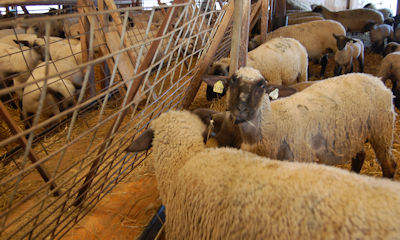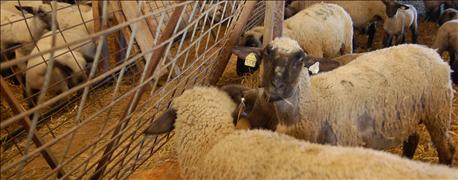February 12, 2016

Mike and Heather Ludlam, Hopkins, Michigan, have raised sheep since 1993. A few years ago something happened they will never forget.
“My sister Dory passed away from Huntington’s Disease,” Mike said. “She was diagnosed in her mid-40s and lived for about ten years following the diagnosis.”

SHEEP VS. HUNTINGTON’S DISEASE: Researchers believe sheep with a genetic trait to produce a compound needed to treat Huntington’s disease could be raised like these normal sheep.
Huntington’s Disease is not Parkinson’s, Alzheimer’s or Schizophrenia, but it can cause symptoms similar to those in all three diseases. Before she was diagnosed, Dory began showing symptoms of what might be construed as a mood disorder - spells of mania and emotional unrest. “She ended up being too much to handle at the house, so my brother-in-law, her husband, had to put her into a nursing home,” he said.
Heather adds, “There are no known cures, treatments or even clinical trials for Huntington’s.”
A key discovery
In the dawn of 2015, three years after Dory’s passing, Mike and Heather decided to scale-up their commercial sheep operation. Around this time, Mike stumbled across a blurb in an email newsletter reading something similar to “Sheep breeders needed to raise sheep for use in Huntington’s Disease research.”
The people whom Heather called that day were Larry and Sue Holler, White, South Dakota. The couple have been raising a flock of sheep with a genetic defect called GM1 Gangliosidosis. GM1 Gangliosidosis causes a sheep’s brain to produce excess of a type of fat called Ganglioside (GM1). GM1 happens to be the same neuro-protectant that Huntington’s and other neurologically disordered patients are deficient in.
Two weeks after speaking to the Hollers about Hersch’s research, Mike and Heather drove to South Dakota to become the 15th producer of sheep with excess GM1.
Heather says, “In the hopeless battle of what Huntington’s is now, we get to have some hope. We get to try to help.”
The Ludlams have committed themselves to raising the funds as much as to raising the sheep, and established an online fundraiser which can be accessed at crowdrise.com/mikeludlamandfamily/fundraiser/heatherludlam.
“Really, we’re just sheep farming like we would any other sheep,” Heather said. “The only caveat is the blood test. And we’re still making breeding selections for good-quality sheep in terms of confirmation and market quality - carriers can still be sold for meat if not for the breeding stock.”
To learn more about the GM1 project, visit glycoscienceresearch.com/.
Explaining the situation
Here’s more information you may want to know about the connection between the genetic trait in sheep and Huntington’s disease. The compound from sheep is still in the testing stages, and not yet approved for human trials, as noted below.
• Symptoms become debilitating Further into the disease Mike Ludlam’s sister Dory began displaying some of Huntington’s physical symptoms: Involuntary jerking or writhing movements, muscle rigidity, abnormal eye movements, impaired gait, posture and balance and difficulty speaking or swallowing. Mike’s wife, Heather, a veterinarian, tried researching treatments for Dory among scientific and medical contacts at that time. The search was fruitless.
• Symptoms can become very severe The home where Dory was initially cared for could not keep up with her needs, so she was transferred to a hospital in Minneapolis, Minnesota that had a Huntington’s wing. “I even hate thinking about how Dory reacted,” Mike said. “She deteriorated mentally and physically, and we just had to sit there and watch. The frustrating part is that you know there’s nothing you can do about it. There’s no cure, there’s no treatment, there’s nothing.”
• Sheep produce compound in their brains. The sheep with the recessive trait produce excessive amounts of GM1 in their brain, spinal cord and organs. It can be harvested from them at slaughter and used for the medical research, Heather Ludlam says.
• Tests on mice so far The scientist working with the Hollers who raise sheep with this defect, Dr. Steven Hersch, is a Huntington’s researcher at Harvard Massachusetts General Hospital. He’s been using the GM1 extracted from sheep in trials with Huntington’s symptomatic mice. By injecting the mice with GM1 or administering it to them nasally, Hersch has seen the mice return to normal in ten days. If positive results occur in human Huntington’s patients as well, treatment with GM1 may lessen or clear up Huntington’s symptoms altogether. The treatment could even extend their lifespan.
• GM1 in excess is a simple recessive trait “We were given rams who are carriers of the trait, and when we breed the carrier offspring together, we get homozygous recessive offspring who have the trait. Those lambs are then sold to the research company,” Heather Ludlam explains.
• Getting good odds Twenty-five percent of the offspring of a carrier ram and carrier ewe will test positive by blood test for an excess of GM1. In their first year of breeding carrier rams to normal ewes, the Ludlams were lucky to have 26 out of 47 lambs test positive as carriers.
• Where GM1 for humans stands in U.S. In January 2015, GM1 was approved by the Food and Drug Administration for pre-investigative drug approval. This does not mean the organic compound can be used for clinical trials in humans, but it is one step closer to that goal. Safety trials, which will realistically take three years to complete, must be run first on animals before clinical trials begin.
The biggest obstacle slowing safety trials is a lack of funding. About $7 to $8 million needs to be raised to advance the research.
More sheep needed
Right now, Heather said the Huntington’s GM1 research also needs to recruit more sheep producers. Raising sheep with excess GM1 is not much different from raising any commercial sheep flock; any breed of sheep can be crossed with the GM1 carrier sheep, and the genetic testing is free. Management-wise, the process differs in that producers must draw a blood sample from lambs during regular tail-docking or ear-tagging, to be sent for testing.
Sheep producers interested in raising sheep with excess GM1 can contact Sue Holler at [email protected]. Selling these sheep to the research company can make a producer $500 per lamb, but for the Ludlams, producing GM1 is not about profit.
- Emma Hopkins is a senior in Purdue University Ag Communications. She writes from West Lafayette.
You May Also Like




